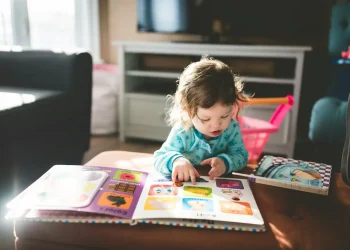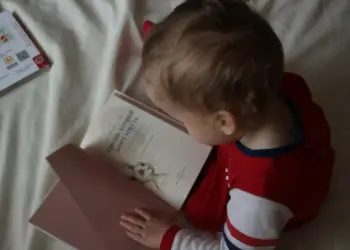Reading aloud to children; It’s not new, but it is fast becoming evident, through research studies, that ‘reading with children from birth is one of the most important activities families, communities and professionals can undertake to enhance their child’s future ability to read and write.’
I had been teaching for ten years when Cammy was born, so I felt quite comfortable and confident reading aloud by then, but I remember feeling completely petrified as I read to a class of children for the very first time. I was reading Blueback by Tim Winton (thankfully the beautiful writing helped me along).
Remembering that feeling made me wonder how some parents must feel when they are told they should be reading aloud to their children, but possibly:
- don’t enjoy reading themselves?
- don’t feel confident about reading aloud?
- doubt their ability to make stories exciting?
- fear they’ll make a fool of themselves by reading aloud?
- have children who won’t sit still for a story?
When I was recently asked by the Australian Scholarships Group what tips I could share with these parents, I tried to take a fly-on-the-wall look at what we do in our home. My children both LOVE stories, and they both refuse to go to sleep without hearing at least one story first, regardless of how tired they are or how busy the day has been. So we must be getting a few things right. Below is a list of things we consciously try to do when reading aloud to our children.
Because not every parent or child is the same, I chatted to some mothers and educators who I find inspiring and asked them to share some tips based on their own experiences. You’ll see these peppered throughout the list.
TEN TIPS FOR READING ALOUD TO CHILDREN
1. Make time to read to your child EVERY day.
Just one book a day is all it takes (but it won’t be long before one of you is requesting more stories).
Reading is a part of our daily routine. We read before every bed or nap time, but I’ll also drop everything to read to my kids if they request a story throughout the day. It is important though, that reading doesn’t come across as a chore.
‘Read to a child with enjoyment in your voice (yes, even if you can recite the words by heart!)’,
2. Relax and get comfortable.
Children really do pick up on our emotions and our fears, so they will know if you are nervous or uninterested. Give yourself every opportunity to feel relaxed: choose the right place to read, choose a book you feel confident reading and read at the right time of the day so that you can give 100% of your attention to reading aloud to your child.
We have a number of cosy places within our home where we can snuggle and be close while we read together. You might set up a dedicated reading space, or you could simply read on the couch, in bed, or on a cushion-laden part of the floor.
Kids should feel relaxed too. Our children like to cuddle their bunnies while we read, and sometimes eat a little snack. And when they were very young, they also liked to have their dummies too.
‘Enjoy the moment and model this to your children: use expression; laugh; create funny voices for each of the characters. Children will long remember a loved adult reading to them with enthusiasm, love, warmth and enjoyment.’
‘When starting out, choose a time of day when both you and your child are feeling relaxed. This doesn’t always need to be at bedtime. We often like to read together in the mornings.’
3. Choose books that you feel confident reading.
They might be familiar books from your own childhood, simple books with very few words or books you’ve read a thousand times before.
Pick a good book! Even some of the best books are not easy to read aloud, so try out a few until you find one that flows well for you.’
‘If you are nervous, familiarise yourself with the book and read it alone.’
4. Use puppets or props.
Puppets and props can take the focus away from you, helping you develop character voice and building your confidence in reading aloud without feeling self-conscious. My kids love to kiss, cuddle and give high-fives to our puppets.
5. Involve your child in the reading.
Make it an active (not a passive) activity for your child. I ask Baby Ike to turn the pages for us and repeat his favourite words. Cammy enjoys predicting parts of stories and she loves asking her own questions about the stories and illustrations.
Encourage kids to join in whenever there’s an opportunity: maybe they can make an animal noise, or be a giant stomping about. And don’t worry if you muddle your character voices. Sometimes I get my voices and characters muddled, but it doesn’t matter. Kids usually point it out, we giggle and move on.’
You don’t necessarily need to read the actual words. Instead you can describe the pictures, point out things with your finger and invite your child to help you.
6. Engage your child’s interest and imagination.
Choosing the right book for your child is one way to engage them, but your voice can also help bring a story to life. Even without training, there are some simple ways you can use your voice when reading aloud. I like to use:
- Volume– Try speaking softly to create suspense or seriousness, or speak loudly to create excitement or importance.
- Pace– Try speaking slowly to create suspense or sadness, or speak quickly to create excitement or panic.
- Tone– emphasise important words from the story (particularly words that indicate emotions)
Show emotion as you read–not only vocally, but with your face, your hands, your body language. Cover your mouth when shocked. Pause and press your hand to your chest when the story becomes suspenseful. Cover your eyes with embarrassment, bite your lips with dread, wipe away tears (real or faux!) upon tragedy. Tease the very essence of the story outwards for your child and they will become truly enraptured.
I like to make different voices for the different characters in the story.
7. Mix it up.
Find different ways to read a book. We like to read in the dark with a torch, wear costumes, sing the words, use silly voices, and read on the trampoline or under a tree.
‘We add sounds and movement as we read (My son’s eyes light up when I rumble and shake the book while reading his favourite about a magic roaring ship.)’
8. Take your child’s lead.
Give your child some control over story time. Let them decide when they want a story, what they want you to read, how they want it to be read, and how often they want you to read the same story. Also, be willing to ‘give up’ or change tact if a book is not working for your child. Don’t get tense if a story session hasn’t been a success.
There have been times when I have let Baby Ike turn the page before I’ve finished reading the words. Other times, I have let him get up to play and go back to the story when he returns to me.
Don’t be disheartened when your toddler asks for the same book time and time again, make a deal that allows you both to choose a book each (their choice first and yours next).
Don’t underestimate the power of familiar books. Read the same books regularly and allow your child to become familiar with the rhythm, the words and how they relate to the pictures.
9. Learn from others.
Watch and listen to other storytellers. Ask other family members to read to your child, visit your local library for story time, watch a segment of Play School or watch online storytellers through resources such as Story Box Library.
10. Persist.
Don’t give up on reading aloud because your child shows signs of not enjoying story time. Start small by using one book with a simple story, and go from there. Try different strategies and techniques until you work out what your child enjoys.
‘Don’t stop reading aloud to kids just because you feel they can read independently; continue to model good reading skills.’
















